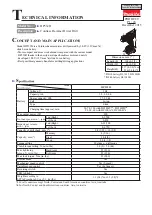
4) Power tool use and care
a)
Do not force the power tool. Use the correct power tool for your application.
The correct power tool will do the job better and safer at the rate for which it was
designed.
b)
Do not use the power tool if the switch does not turn it on and off.
Any power
tool that cannot be controlled with the switch is dangerous and must be repaired.
c)
Disconnect the plug from the power source before making any adjustments,
changing accessories, or storing power tools.
Such preventive safety
measures reduce the risk of starting the power tool accidentally.
d)
Store idle power tools out of the reach of children and do not allow persons
unfamiliar with the power tool or these instructions to operate the power tool.
Power tools are dangerous in the hands of untrained users.
e)
Maintain power tools. Check for misalignment or binding of moving parts,
breakage of parts and any other condition that may affect the power tools
operation. If damaged, have the power tool repaired before use.
Many
accidents are caused by poorly maintained power tools.
f)
Keep cutting tools sharp and clean.
Properly maintained cutting tools with sharp
cutting edges are less likely to bind and are easier to control;
g)
Use the power tool, accessories and tool bits etc., in accordance with these
instructions and in the manner intended for the particular type of power tool,
taking into account the working conditions and the work to be performed.
Use of the power tool for operations different from intended could result in a
hazardous situation.
5) Battery tool use and care
a)
Recharge only with the charger specified by the manufacturer.
A charter that is
suitable for one type of battery pack may create a risk of fire when used with another
battery pack.
b)
Use power tools only with specifically designated battery packs.
Use of any
other battery packs may create a risk of injury and fire.
c)
When battery pack is not in use, keep it away from other metal objects, lie
paperclips, coins, keys, nails, screws or other small metal objects, that can
make a connection from one terminal to another.
Shorting the battery terminals
together may cause burns or a fire.
d) Under abusive conditions, liquid may be ejected from the battery; avoid
contact. If contact accidentally occurs, flush with water. If liquid contacts eyes,
additionally seek medical help.
Liquid ejected form the battery may cause irritation
or burns.
6) Service
Have your power tool serviced by a qualified repair person using only identical
replacement parts. This will ensure that the safety of the power tool is maintained.
4
Summary of Contents for PT-1080
Page 2: ...1...
Page 12: ...PT 1080 10 8V 1300mAH 11...
Page 13: ...1 a b c 2 a b c d e f RCD residual current device RCD 3 a b c d e f g h i 4 a b c 12...
Page 14: ...d e f g 5 a b c 2 d 6 a a b c 2 d 13...
Page 16: ...1 2 3 230V 50HZ 4 5 10mm 15...
Page 17: ...21 1 2 1100rpm 350rpm LED 1 1 2 16...
Page 18: ...3 4 5 6 7 8 17...
Page 19: ...18...
Page 20: ...19 2011 Prokit s Industries Co LTD All rights reserved 2011001 C...






































